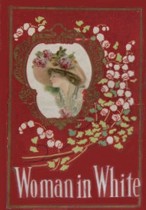 Wilkie Collins •
Wilkie Collins •
The Woman in White •
Wilkie Collins is the best Victorian novelist you’ve never heard of, and The Woman in White is rightfully considered his masterwork.
It’s also been called the first detective novel ever written in English. You can judge for yourself, while you’re drawn into the intrigue of a veiled woman who appears out of a misty night, begs for help, and then vanishes, leaving the young man she has appealed to in a state of intense agitation. Throughout the rest of the book he tries to learn her secret—piecing together scattered clues in a crumbling graveyard, a country manor, a boathouse, even the Paris morgue.
Much like Dickens, his friend and mentor, Collins possesses the ability to hold your interest through a long, complex story with myriad characters and dramatic plot twists. Unlike Dickens, however, he rarely indulges in humor; Collins’s forte is spine-tingling suspense, and he does an admirable job of keeping you on the edge of your seat for 617 pages. He is also skilled at using multiple narrators; in various chapters we hear from a petulant invalid (“It is the grand misfortune of my life that nobody will let me alone”), a sinister count (“What! you think I shall poison you?”), and a strong-willed jolie laide (“I was almost wicked enough to wish that Baxter had shot the housemaid instead of the dog”), as well as the young drawing master who tries to unravel the mystery.
Collins pulls out the stops—abduction, false identity, anonymous warnings, a secret society—yet his masterful characterization and story structure render The Woman in White totally absorbing. If your picture of Victorian England has been largely shaped by the fiction of Dickens and Thackeray, here’s an opportunity to look through a different lens.






Your email address will not be published.